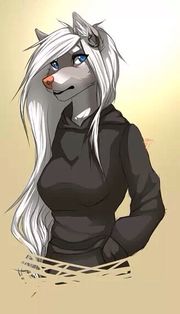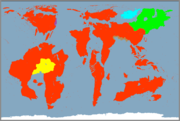Species of The East Pacific
| Feline | |
| Scientific Classification | |
| Kingdom | Animalia |
| Phylum | Chordata |
| Class | Mammalia |
| Order | Carnivora |
| Family | Hominidae |
| Genus | Felis |
| Species | F. sapiens |
| Binomial Name | |
| Felis sapiens Linnaeus, 1758 | |
| Lupine | |
| Scientific Classification | |
| Kingdom | Animalia |
| Phylum | Chordata |
| Class | Mammalia |
| Order | Carnivora |
| Family | Hominidae |
| Genus | Canis |
| Species | C. sapiens |
| Binomial Name | |
| Canis sapiens Linnaeus, 1758 | |
| Vulpine | |
| Scientific Classification | |
| Kingdom | Animalia |
| Phylum | Chordata |
| Class | Mammalia |
| Order | Carnivora |
| Family | Hominidae |
| Genus | Vulpes |
| Species | V. sapiens |
| Binomial Name | |
| Vulpes sapiens Linnaeus, 1758 | |
| Human | |
| Scientific Classification | |
| Kingdom | Animalia |
| Phylum | Chordata |
| Class | Mammalia |
| Order | Primates |
| Family | Hominidae |
| Genus | Homo |
| Species | H. sapiens |
| Binomial Name | |
| Primus sapiens, Homo Sapiens Linnaeus, 1758 | |
| Procyne | |
| Scientific Classification | |
| Kingdom | Animalia |
| Phylum | Chordata |
| Class | Mammalia |
| Order | Carnivora |
| Family | Procyonidae |
| Genus | Procyon |
| Species | P. sapiens |
| Binomial Name | |
| Procyon Sapiens Linnaeus, 1758 | |
Felines
Felines are a species of cat-like humanoids who share both cat and human-like characteristics. Similar to their less evolved counterparts, the species is split into breeds - those these are identified as ethnic groups. These ethnic groups share similar body characteristics, but differ in fur length, fur color, and other traits.
Lupines
Main article: Lupines
Lupines are a species of wolf-like humanoids who share both wolf and human-like characteristics. Similar to their canine counterparts, the species is split into breeds - those these are identified as ethnic groups. These ethnic groups share similar body characteristics, but differ in fur length, fur color, and other traits.
Vulpines
Main article: Vulpines
The vulpine sentient race is a specific group of anthropomorphic humanoids with many recognizable "fox" features and characteristics. While not as furry as their animal counterpart, vulpines do in general have similar fur markings, with red and white being the most popular colors. Their bodies consist of a larger brain capable of more precise and faster execution. Senses are heightened. The vulpine body is agile, allowing for good dexterity.
The race is regarded as "thin", as their bodies lack a subcutaneous layer common among humans and humanoid species. This can serve as a determent for adapting to different climates. Furthermore, vulpines tend to lack physical strength due to their small frames. Life expectancy is less than that of an average human.
Two sub-groups exist: the northern and southern variants. Northern variants, which tend to hail from Vulshain, have denser, longer fur due to colder climate conditions. Southern variants, which are commonly found in Vekaiyu, Listonia, Isklevyu, and Yishevyu, have shorter, oily fur, which is useful for swimming.
Humans
Main Article: Humans
Modern humans are the most populous sentient species on Urth. They are characterized, as are all humanoids, by erect posture and bipedal locomotion; manual dexterity and increased tool use, compared to other animals; and a general trend toward larger, more complex brains and societies. In order to bring scientific clarity to nomenclature, recently the use of Primus Sapiens has been used more than Homo Sapiens by contemporary Terran scientists.
Nekomimis
Dwarves
Dwarves are found in the country Bal'Morag, on the continent Atlantia.
Procynes
Main Article: Procynes
Procynes are a racooon-like species that can be found in Southwestern Gondwana, primarily on the western peninsula. Characterized by their shorter stature when compared to other bipedal species, Procynes have four primary variants: Tropical, Northern, Central, and Southern. Tropical are similar in fur type to vulpines, however are less oily than vulpine fur. Northern variants have thick fur, but lack the fat layer that Central and Southern variants have. It must be noted that the Northern and Southern variants do not have as thick a layer of fur as the Southern variant.





